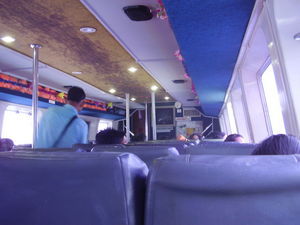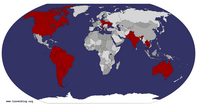Advertisement
Published: August 12th 2007

 Ride to Sihanoukville
Ride to Sihanoukville
Fast boat....bumpy ride...With no competition except for a bus route which takes the same four hours, Cambodians and foreigners alike, have no choice to pay the astronomical twenty dollar fare for the boat out of Koh Kong. Having taken a look around the center of Koh Kong after my painful twelve dollar taxi ride from the border resort, the price is a bargain. I would pay double to be elsewhere. The boat is a high speed dolphin variety I recall from hopping years ago from one Aegean island to another. Dockworkers load the roof of the vessel with sacks of provisions: detergent, vegetables, scrap metal, and addressed parcels for individual recipients. Two touts take my pack from me and stow it below. When I thank them, they surround me for a tip, having completed a service I did not request.
“You give us money now for bag.”
“I don’t have much, a few baht.” I tossed a few coins in each right hand. Their reaction was stern. I really pissed them off.
“We want more money. Twenty baht.” I have learned that an exaggerated grin sends an accurate message. So does a pat on the shoulders. Most tourists relent and hand over more

 Sihanoukville - Beachside
Sihanoukville - Beachside
The pride and joy of the Cambodian coast?money to relieve themselves of the uncomfortable situation. I didn’t
“No, I have no more.” Unless they were able to break a fifty dollar bill, I thought this scenario unlikely. They stared fiercely at me and violated my personal space.
“No more! Go!” I was firm but never raised my voice. Yelling at other people in Southeast Asia is bad form. They knew their tactics would not work and departed with harsh words for me in Khmer. The British couple that next boarded did not fare as well. Their first mistake was to acknowledge them. They engaged the pair and got into an argument. This caused a scene and embarrassment for the English couple. Forty baht later, the touts were gone.
The boat in any shade of light is way past prime. The ripped upholstery speckles with different colors of paint much like a second grade art project. The tinted film on the windows has peeled away. I settle in for a bumpy ride with the surprising realization that my seats are comfy and I have an uninterrupted, though too shaded view of the sea for the next four hours. On the far side of the cabin, passengers take in

 More Reality
More Reality
One block away from the main drag in the center of town...the undeveloped Cambodian coast, which is in sharp contrast to what its Western neighbor has done with its shoreline.
The boat is designed to slice through ocean waves. Yet at speeds over forty miles per hour, it is a bumpy ride two miles offshore. Within one hour, the familiar sounds of vomiting and heaving start first in back of me, and then from the other side of the aisle. Some passengers suffer such unexpected and violent spells that they do not have time to reach for and place the black plastic bag over their faces. Ancillary requirements of being on board staff include distributing toilet paper and compassionately rubbing the backs of bent over barfing passenger in order to soothe their misery. Between heaving episodes the young porter and ticket agent sprays a floral air freshener about the cabin. Yet it is too late: The liquid mix of bile and breakfast run under a few rows of seats. Only minutes later, speedy cockroaches appear to investigate.
The men and women had no choice but to board the boat. There were not bound for Sihanoukville, rather the one stop at an offshore island. Much like many Loatians who must suffer hour-long

 Warning!
Warning!
Hands of Cambodian children...twists and turns on the road. There is no solution for their motion illness but to hope it will not strike with merciless vehemence.
Most arrive inb town at an open parking lot that also serves as a trash receptacle and bus station. I had the misfortune of taking in the first sights and smells of Sihanoukville at the ferry port, no more than a rickety conglomeration of weak planks and stilts sticking out into the harbor. I duck and avoid the crowds to finally step on what I thought would be firm land. My feet sunk into inches of mud, two hundred feet short of the main road. The ferry port is a disorganized mess of trash dilapidated huts, a labyrinth of parked but running mopeds, and partially buried plastic bags. Everything is caked in mud. Touts attempt to remove my pack from my back from every direction. In a hut stilted over the harbor, welders fuse metal poles together at right angles. Their only protection is the pair of shorts they have on. I find solid pavement and walk towards the green hills of town. Eventually, a tuk-tuk driver and I agree on a price and he takes me away from the shoreline, but not before an endless stream of shanties, grime, and indescribable odor. While aboard the tuk-tuk, the cool air begins to dry out my shirt. My mind brings me back to the worst transportation terminal by any means I have known: air, boat, train, or bus. The Esatción del Oriente in San Salvador had always held that dubious honor. Now I have to reconsider.
Sihanoukville basks in mediocrity. Only a little more than fifty years old, The country’s principal seaport was built in honor of the Cambodian monarch at the time. Before the nineten fifties, Cambodia used the Mekong as its principal access to the sea. That all ended when the Indochina War dragged Vietnam into years of conflict with its neighbors and encroaching Western powers.
Sihanoukville is known within the traveling circuit as the place to unwind after withstanding Cambodia’s refined outer provinces. The peloton of backpackers and packaged tourists take to the city’s glitzy hotels and beach bars for unwinding and entertainment. With Thailand and Indonesia a short flight away or an easy adjustment to anyone’s plans, the only question I have is: Why Sihanoukville?
The beaches? You have to be kidding me. They are second rate at best, even though the stretch of anticipated beach bars and restaurants are truly fine for relaxing. Lanes leading to the three principal beaches are polluted, hard to access, or steeped in weeks-old trash. Serendipity Beach hasn’t seen a rake in years. The water is not inviting.
Sihanoukville’s downtown serves its purpose, but no more. It is the primary central atom of a carbohydrate molecule. The beaches act as the outer hydrogen and oxygen atoms. It is impossible to get from one beach to the other on foot. As there are no buses, tuk-tuks are readily available. But there are no tuk-tuks downtown, meaning visitors are stuck with grabbing a ride from the hundreds of men hailing foreign pedestrians with their arms or horns, screaming “Motorbike?” My driver zipped me back to my hotel on the main thoroughfare in the opposite lane going the wrong way. There was less traffic and no hassle this way. At night, who would care? There are few cars out on the road anyway.
Foreign-owned bars and restaurants gather up and hoard all of the revenues save the guesthouses. Foreign faces in a restaurant equate to foreign owned. This usually results in travelers frequenting these establishments, right or wrong, because of a perceived notion of proper service and cleanliness.
Angelo teaches his novice staff the basic pointers of taking care of foreign customers while on vacation. His Mediterranean restaurant (read: Greek) has been open for two months. His Thai wife takes care of the books and calls out instructions for the willing new hires. But the dark-skinned fifty-year old Greek ex-pat gets frustrated at a staff that has no concept of due diligence or basic cleanliness. Unless the young men are told precisely what to do and how, they automatically revert to text messaging friends on cell phones. Meanwhile, floors need sweeping, tables clearing, and I need another beer. My glass has stood empty in front of his newest young hire, a twenty-year-old Khmer girl. She looks at my glass and does nothing. Angelo comes over and patiently shows her that it is best to ask if I would like another drink, or I might go to another bar for a meal next time. The girl is attentive and nods her head. Young Cambodians are not afraid to work hard. Right now, many have never learned how to work hard. It will take weeks for her to understand the concept she will now put into effect.
The CD player is violently skipping, destroying beautiful Cuban Samba. Angelo sprints from the tables by the street to fix it himself.
I feel I owe the city another look. Cambodians and ex-pats scoff at my dismissal of the nation’s premier coastal retreat. But no one has made an argument as to why anyone would want to come here. Oh, it’s so much better than before!” they exclaim. “The hotels are modern and there are restaurants on the beach.” Sihanoukville just does not do it for me. Off the trodden footpath from which few foreigners venture, the central food market is an insect-infested mud field of slop. There is nowhere to move and the air is abhorrent. By the Golden Lions traffic circle, a billboard warns visitors not to engage in child sexual exploitation. Sihanoukville is a city of idle men on mopeds and frantically busy women raising children, cooking, cleaning, and merely trying to break even at the end of the day.
Sihanoukville? Sure, whatever. At any rate, the Chamber of Commerce won’t be calling on me to speak at their next big public engagement.
Advertisement
Tot: 0.07s; Tpl: 0.012s; cc: 8; qc: 24; dbt: 0.0486s; 1; m:domysql w:travelblog (10.17.0.13); sld: 1;
; mem: 1.1mb











